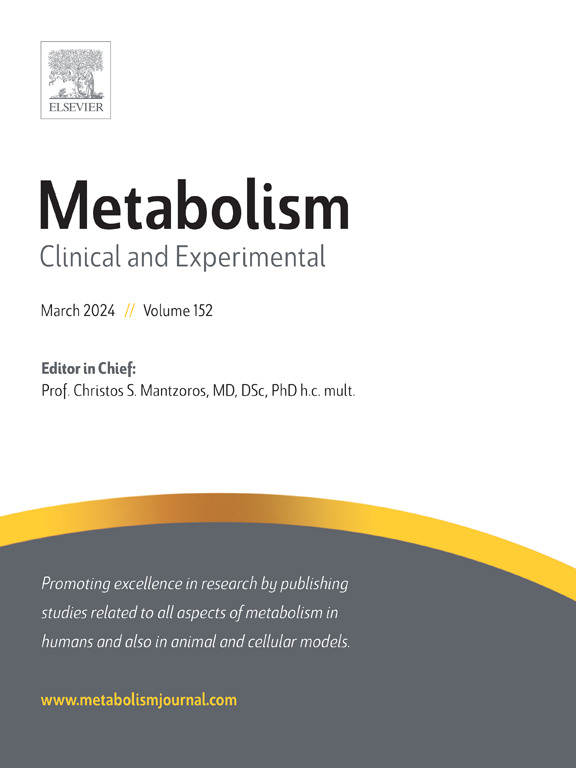Accurate non-invasive detection of MASH with fibrosis F2-F3 using a lightweight machine learning model with minimal clinical and metabolomic variables
IF 10.8
1区 医学
Q1 ENDOCRINOLOGY & METABOLISM
引用次数: 0
Abstract
Background
There are no known non-invasive tests (NITs) designed for accurately detecting metabolic dysfunction-associated steatohepatitis (MASH) with liver fibrosis stages F2-F3, excluding cirrhosis—the FDA-defined range for prescribing Resmetirom and other drugs in clinical trials. We aimed to validate and re-optimize known NITs, and most importantly to develop new machine learning (ML)-based NITs to accurately detect MASH F2-F3.
Methods
Clinical and metabolomic data were collected from 443 patients across three countries and two clinic types (metabolic surgery, gastroenterology/hepatology) covering the entire spectrum of biopsy-proven MASH, including cirrhosis and healthy controls. Three novel types of ML models were developed using a categorical gradient boosting machine pipeline under a classic 4:1 split and a secondary independent validation analysis. These were compared with twenty-three biomarker, imaging, and algorithm-based NITs with both known and re-optimized cutoffs for MASH F2-F3.
Results
The NAFLD (Non-Alcoholic Fatty Liver Disease) Fibrosis Score (NFS) at a − 1.455 cutoff attained an area under the receiver operating characteristic curve (AUC) of 0.59, the highest sensitivity (90.9 %), and a negative predictive value (NPV) of 87.2 %. FIB-4 risk stratification followed by elastography (8 kPa) had the best specificity (86.9 %) and positive predictive value (PPV) (63.3 %), with an AUC of 0.57. NFS followed by elastography improved the PPV to 65.3 % and AUC to 0.62. Re-optimized FibroScan-AST (FAST) at a 0.22 cutoff had the highest PPV (69.1 %). ML models using aminotransferases, metabolic syndrome components, BMI, and 3-ureidopropionate achieved an AUC of 0.89, which further increased to 0.91 following hyperparameter optimization and the addition of alpha-ketoglutarate. These new ML models outperformed all other NITs and displayed accuracy, sensitivity, specificity, PPV, and NPV up to 91.2 %, 85.3 %, 97.0 %, 92.4 %, and 90.7 % respectively. The models were reproduced and validated in a secondary sensitivity analysis, that used one of the cohorts as feature selection/training, and the rest as independent validation, likewise outperforming all other applicable NITs.
Conclusions
We report for the first time the diagnostic characteristics of non-invasive, metabolomics-based biomarker models to detect MASH with fibrosis F2-F3 required for Resmetirom treatment and inclusion in ongoing phase-III trials. These models may be used alone or in combination with other NITs to accurately determine treatment eligibility.

利用轻量级机器学习模型,以最少的临床和代谢组学变量,对纤维化 F2-F3 的 MASH 进行准确的无创检测。
背景:目前还没有一种已知的非侵入性检测方法(NIT)可用于准确检测肝纤维化分期为F2-F3(不包括肝硬化)的代谢功能障碍相关性脂肪性肝炎(MASH)--FDA规定的Resmetirom和其他药物的临床试验处方范围。我们的目标是验证和重新优化已知的NIT,最重要的是开发新的基于机器学习(ML)的NIT,以准确检测MASH F2-F3:收集了来自三个国家、两种诊所类型(代谢外科、胃肠病学/肝病学)的 443 名患者的临床和代谢组学数据,涵盖了活检证实的 MASLD 的整个范围,包括肝硬化和健康对照组。利用分类梯度提升机器管道开发了三种新型 ML 模型。这些模型与 24 个基于生物标志物、成像和算法的 NIT 进行了比较,其中既有已知的 MASH F2-F4 临界值,也有重新优化的 MASH F2-F3 临界值:以 - 1.455 为临界值的 NFS 的 AUC 为 0.59,灵敏度最高(90.9%,95% CI 84.3-95.4),NPV 为 87.2%。通过弹性成像(8 kPa)进行 FIB4 风险分层的特异性(86.9%)和 PPV(63.3%)最高,AUC 为 0.57。NFS 后进行弹性成像可将 PPV 提高到 65.3%,AUC 提高到 0.62。重新优化的纤维扫描-AST (FAST) 以 0.22 为临界值,PPV 最高(69.1%)。使用转氨酶、代谢综合征成分、体重指数和 3-ureidopropionate 的 ML 模型的 AUC 为 0.89,在超参数优化和加入 alpha-ketoglutarate 后,AUC 进一步增至 0.91。这些新的 ML 模型优于所有其他 NIT,其准确性、灵敏度、特异性、PPV 和 NPV 分别高达 91.2%、85.3%、97.0%、92.4% 和 90.7%。这些模型在二次敏感性分析中得到了重现和验证,其中一个队列作为特征选择/训练,其余队列作为独立验证,结果同样优于所有其他 NITs:我们首次报告了非侵入性、基于代谢组学的生物标记物模型的诊断特征,这些模型可检测出MASH纤维化F2-F3,这是Resmetirom治疗和纳入正在进行的III期试验的必要条件。这些模型可单独使用,也可与其他 NITs 结合使用,以准确确定治疗资格。
本文章由计算机程序翻译,如有差异,请以英文原文为准。
求助全文
约1分钟内获得全文
求助全文
来源期刊

Metabolism: clinical and experimental
医学-内分泌学与代谢
CiteScore
18.90
自引率
3.10%
发文量
310
审稿时长
16 days
期刊介绍:
Metabolism upholds research excellence by disseminating high-quality original research, reviews, editorials, and commentaries covering all facets of human metabolism.
Consideration for publication in Metabolism extends to studies in humans, animal, and cellular models, with a particular emphasis on work demonstrating strong translational potential.
The journal addresses a range of topics, including:
- Energy Expenditure and Obesity
- Metabolic Syndrome, Prediabetes, and Diabetes
- Nutrition, Exercise, and the Environment
- Genetics and Genomics, Proteomics, and Metabolomics
- Carbohydrate, Lipid, and Protein Metabolism
- Endocrinology and Hypertension
- Mineral and Bone Metabolism
- Cardiovascular Diseases and Malignancies
- Inflammation in metabolism and immunometabolism
 求助内容:
求助内容: 应助结果提醒方式:
应助结果提醒方式:


